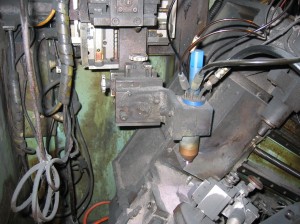Welding

As I continue working on my book I have come to a section that has been difficult to classify. Chapter 7 concerns the various trades that are involve working in the automation field. The first part describes primarily engineering and design functions including Applications, Project Management and Sales while the second part discusses some of the trade skills including Machining, Assembly, Panelbuilding and Welding. When I got to the welding part I started doing some research into the different types of welding and realized that the book may need another section, one that details techniques. After all, some of the machines I have built in the past actually did the welding, sometimes robotically, sometimes simply applying a tack weld to a point. I have also worked on several weld inspection systems using vision.

Following is an excerpt from Chapter 7 that I am talking about. While many of the other job descriptions simply describe the tasks that are employed, this one actually contained technical information, hence my thoughts of placing it in a different section. From the chapter:
Machine frames are often welded for stability. Piping systems are also commonly welded. There are several different methods of welding including arc welding, gas welding, resistance welding, or for production environments laser or electron beam welding.
One of the most common types of arc welding is shielded metal arc welding (SMAW). It is also known as manual metal arc welding (MMA) or stick welding. Electric current is used to strike an arc between the base material and consumable electrode rod, which is made of steel and is covered with a flux that protects the weld area from oxidation and contamination by producing carbon dioxide (CO2) gas during the welding process. The electrode core itself acts as filler material, making a separate filler unnecessary.
Gas metal arc welding (GMAW), also known as metal inert gas or MIG welding, is a semi-automatic or automatic process that uses a continuous wire feed as an electrode and an inert or semi-inert gas mixture to protect the weld from contamination. Since the electrode is continuous, welding speeds are greater for GMAW than for SMAW.
A related process, flux-cored arc welding (FCAW), uses similar equipment but uses wire consisting of a steel electrode surrounding a powder fill material. This cored wire is more expensive than the standard solid wire and can generate fumes and/or slag, but it permits even higher welding speed and greater metal penetration.
Gas tungsten arc welding (GTAW), or tungsten inert gas (TIG) welding, is a manual welding process that uses a nonconsumable tungsten electrode, an inert or semi-inert gas mixture, and a separate filler material.Especially useful for welding thin materials, this method is characterized by a stable arc and high quality welds, but it requires significant operator skill and can only be accomplished at relatively low speeds.
GTAW can be used on nearly all weldable metals, though it is most often applied to stainless steel and light metals. It is often used when quality welds are extremely important, such as in bicycle, aircraft and naval applications. A related process, plasma arc welding, also uses a tungsten electrode but uses plasma gas to make the arc. The arc is more concentrated than the GTAW arc, making transverse control more critical and thus generally restricting the technique to a mechanized process. Because of its stable current, the method can be used on a wider range of material thicknesses than can the GTAW process and it is much faster. It can be applied to all of the same materials as GTAW except magnesium, and automated welding of stainless steel is one important application of the process. A variation of the process is plasma cutting, an efficient steel cutting process.
Welders often attend training schools and require certification for their trade. Like machinists, welders also require a good background in the properties and behavior of metals.
End of the description so far. As you can see, this doesn’t concern the occupation of welding as much as it does the different welding techniques. There are a number of other descriptions that have the same problem of needing to be split into different areas of the book and I am continuing to address them. Writing a book is maybe a bit more time consuming than I had thought!

Thank you very much for this post. You really shared very nice information which you know. I appreciate your post because it is very helpful and thanks a lot to you.
sheet metal fabrication
Thanks for your information.
Most of people do not know about welding process even a welder.You donate your knowledge to the world and you will be on top in your field because of your donation.I wish you good-luck.